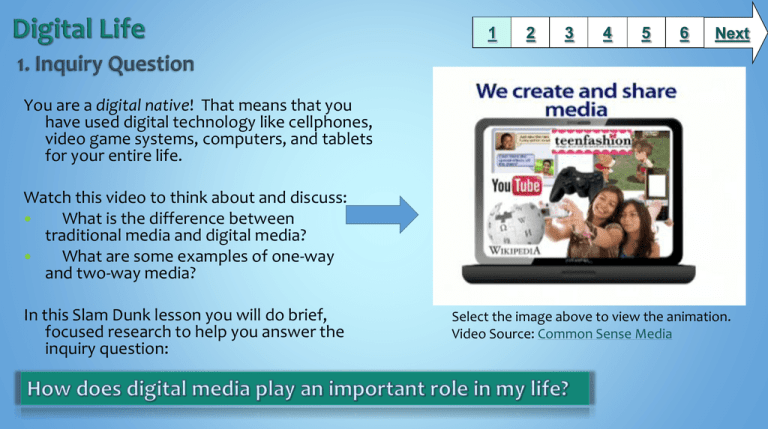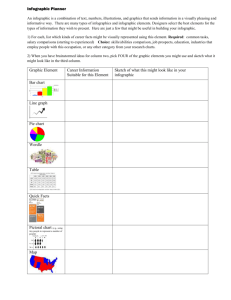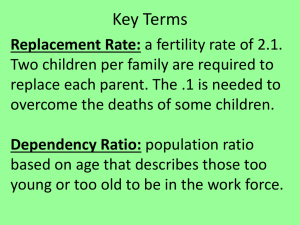
1
2
3
4
5
6
Next
You are a digital native! That means that you
have used digital technology like cellphones,
video game systems, computers, and tablets
for your entire life.
Watch this video to think about and discuss:
What is the difference between
traditional media and digital media?
What are some examples of one-way
and two-way media?
In this Slam Dunk lesson you will do brief,
focused research to help you answer the
inquiry question:
Select the image above to view the animation.
Video Source: Common Sense Media
1
2
3
4
5
6
Next
You will use these sources to learn about
digital media and its role in our everyday lives
to complete the Student Activity on Slide 3:
• Brain Pop-Social Networking*
• Brain Pop-Email and IM *
• Brain Pop-Microblogging *
* You must first log on to BCPSOne and click/tap the
BrainPop icon authenticate, then return to this slide to
select the BrainPop links.
•
•
•
•
•
Teens Spending Time Consuming Media
How Teens View Their Digital Lives
What’s Trending in Teen Digital Media
How Teens View Their Digital Life (Infographic)
Living Life Online (PDF)
Select the image above to watch
a video about the Digital Youth
Network in Chicago, Illinois.
1
1) As you explore the
resources on Slide 2, use
this NOTES ORGANIZER to
gather information about
different types of media
that you use, how you use
them, your feelings about
your media usage, and your
parents’ feelings about it.
2
3
4
5
6
Next
This concept map from
Common Sense Media
2) Use the information from your notes and your own life experience to create a concept map
about the role of digital media in your life. Include the types of digital media you use, how you
use them, and what kinds of feelings this creates for you and your parents. Use a digital
concept-mapping tool or low-tech tools of your choice to create your concept map.
1
2
3
4
5
6
Next
How much time do you spend using digital media?
• Think about your typical day from the moment you wake up
to when you go to bed. Complete this MEDIA LOG for all
the digital media you use.
• Use the data from your log to create an Infographic about
your use of digital media.
• Compare your use of media to that of your peers by
examining their infographics. Do you spend more or less
time in front of the screen?
Tools for Making an Infographic:
•
•
•
•
•
Discovery Education BoardBuilder - support page
Wixie (access through BCPSOne) - support page
Microsoft PowerPoint
Another approved digital tool of your choice
Low-tech tools of your choice (paper, colored pencils,
pictures cut out of old magazines, etc.)
Use the success criteria on this rubric as a guide and
to self-evaluate your work.
Select the image above to view a larger infographic
about how many hours and minutes the average person
spends with media each day.
1
2
3
4
5
6
Next
Now that you know how to create an infographic, use what
you’ve learned about media usage to create another infographic
illustrating a “healthy media diet”.
This infographic should show what you think a healthy
percentage of media use or alternative activities should be in
the day of a middle school student.
You can base your “healthy media diet” infographic design on
healthy eating infographics like the one shown below; click on
the image to see a larger version.
Select the image above to view a larger infographic about the
amount of screen times adolescents use during their average day,
and what they could be doing instead. From the CDC
1
Maryland Technology Literacy Standards
Standard 2.0 Digital Citizenship: Demonstrate an understanding of the history of technology and its impact on society, and
practice ethical, legal, and responsible use of technology to assure safety.
Common Core State Standards
grade 6: RI.7, RI.10, W.4, W.6, W.10, SL.1a, SL.1b, SL.1c, SL.1d, SL.2, SL.5, SL.6, L.6
grade 7: RI.10, W.4, W.6, W.10, SL.1a, SL.1b, SL.1c, SL.1d, SL.2, SL.5, SL.6, L.6
grade 8: RI.10, W.4, W.6, W.10, SL.1a, SL.1b, SL.1c, SL.1d, SL.2, SL.5, SL.6, L.6
Standards for the 21st Century Learner
1.1.6 Read, view, and listen for information presented in any format (e.g. textual, visual, media, digital) in order to make
inferences and gather meaning.
2.1.3 Use strategies to draw conclusions from information and apply knowledge to curricular areas, real-world situations, and
further investigations.
3.1.6 Use information and technology ethically and responsibly.
3.1.4 Use technology and other information tools to organize and display knowledge and understanding in ways that others
can view, use, and assess.
ISTE Standards for Students
1. Creativity and innovation: Students demonstrate creative thinking, construct knowledge, and develop innovative products
and processes using technology. a. Apply existing knowledge to generate new Ideas, products, or processes. b. Create original
works as a means of personal or group expression
3. Research and Information Fluency: Students apply digital tools to gather, evaluate, and use information.
b. Locate, organize, analyze, evaluate, synthesize, and ethically use information from a variety of sources and media.
4. Critical Thinking, Problem Solving, and Decision Making: Students use critical thinking skills to plan and conduct research,
manage projects, solve problems, and make informed decisions using appropriate digital tools and resources. c. Collect and
analyze data to identify solutions and/or make informed decisions.
5. Digital Citizenship : Students understand human, cultural, and societal issues related to technology and practice legal
and ethical behavior. 5a. Advocate and practice safe, legal, and responsible use of information and technology.
P21 Skills
Information Literacy: Access information efficiently (time) and effectively (sources); Use information accurately and
creatively for the issue or problem at hand.
2
3
4
5
6
Digital Citizenship: Middle School Grades 6-8
Time Frame:
•
1 hour for research
•
1 hour to create research product (Infographic)
Differentiation strategies for this lesson:
•
Allow students to use digital or low-tech tools of their choice to
create an Infographic about their digital lives.
•
Information sources on Slide 2 are in a variety of media formats to
address various learning preferences.
•
Students could work with a partner or small group to complete the
Student Activity on Slide 3 and/or assessment on Slide 4
Notes to the teacher:
•
Collaborate with your school library media specialist to implement
this lesson.
•
Lesson content used or adapted from Common Sense Media
lessons My Media and Digital Life 101. Please review these lessons
before implementing the SlamDunk research model to gain a
broader scope of the lesson content.
ICT Literacy: Use technology as a tool to research, organize, evaluate and communicate information.
Apply a fundamental understanding of the ethical/legal issues surrounding the access and use of information
technologies.
Last updated: July 2015
Created by Linda Brown, Library Media Specialist, revised by Anna Conner, Library Media Specialist
BCPS Slam Dunk Research Model, Copyright 2014, Baltimore County Public Schools, MD, all rights reserved. The models may be used for educational, non-profit school use only.
All other uses, transmissions, and duplications are prohibited unless permission is granted expressly. This lesson is based on Jamie McKenzie’s Slam Dunk Lesson module.




